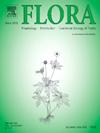Contribution of metabolic and physiological research for future conservation efforts of Himantoglossum Spreng. (Orchidaceae) species
IF 1.7
4区 生物学
Q3 ECOLOGY
引用次数: 0
Abstract
This study aimed to examine the morphological characteristics and chemical compositions of seeds from five Himantoglossum (Himantoglossum calcaratum (Beck) Schltr., Himantoglossum caprinum (M.Bieb.) Spreng., Himantoglossum comperianum (Steven) P.Delforge, Himantoglossum montis-tauri Kreutz & W.Lüders and Himantoglossum robertianum (Loisel.) P.Delforge) species. Himantoglossum Spreng. is a unique genus of orchids found mostly in Europe, North Africa, and western Asia. It includes around 9 recognised species, although this number may change with further research. These orchids typically grow in Mediterranean areas, favouring calcareous soils. They are often found in open woodlands, grasslands, and scrublands. Himantoglossum species are easily recognised by their large, uniquely shaped central petals (lip), which give the flowers a striking appearance. The flowers are usually a mix of purple, pink, and white colours designed to attract various pollinators. Key features of this genus include their long flower racemes and petals that twist or spiral, setting them apart from other orchids. Each species group consisted of fifty seeds, which underwent size, embryo dimensions, and chemical composition analyses. Chemical analyses were conducted to identify the characteristic chemical compounds in the studied Himantoglossum taxa and to compare these compounds with those found in closely related species. These analyses aim to provide a deeper understanding of the chemical profiles of each taxon, offering valuable data to clarify their phylogenetic relationships. By highlighting species-specific chemical markers, the study seeks to strengthen the taxonomic distinctions between species and contribute to a more precise and reliable classification within the genus. Infrared spectroscopy and GC-MS analysis were used for these analyses. The infrared spectroscopy results showed that seeds from Himantoglossum species exhibited overall similarities, but variations in absorbance values were observed at specific wavelengths. Notably, H. montis-tauri exhibited distinct characteristics compared to other species. Furthermore, GC-MS analyses revealed differences in chemical composition among the species. Each species contained specific chemical compounds, accounting for observed variations. H. robertianum contained unique compounds, such as methoxyacetic acid benzyl ester (0.25%), H. caprinum contained diethyl phthalate (0.75%), H. comperianum had trimethylsilyl methaneperoxoate (3.29%), hydrazinecarbothioamide (1.93%), 2-methyl eicosane (0.26%), cyclosativene (0.53%), and octadecenoic acid methyl ester (0.50%). Meanwhile, H. montis-tauri contained specific compounds, including dimethoxymethyl silane (2.34%), hydracrylic acid hydrazide (1.93%), β-longipinene (1.42%), and 3-butoxy-1,1,1,7,7,7-hexamethyl-3,5,5-tris(trimethylsiloxy)tetrasiloxane (0.58%). In conclusion, this study elucidates differences and similarities in seed morphology and chemical composition among Himantoglossum species. Findings from seed morphologies and chemical contents were used to interpret the distribution ecology of the species and the morphological differences used in their distinction. These findings contribute to understanding interspecies relationships and adaptations, highlighting the potential utility of Himantoglossum species' chemical profiles in species identification and taxonomic research.
求助全文
约1分钟内获得全文
求助全文
来源期刊

Flora
生物-植物科学
CiteScore
3.30
自引率
10.50%
发文量
130
审稿时长
54 days
期刊介绍:
FLORA publishes original contributions and review articles on plant structure (morphology and anatomy), plant distribution (incl. phylogeography) and plant functional ecology (ecophysiology, population ecology and population genetics, organismic interactions, community ecology, ecosystem ecology). Manuscripts (both original and review articles) on a single topic can be compiled in Special Issues, for which suggestions are welcome.
FLORA, the scientific botanical journal with the longest uninterrupted publication sequence (since 1818), considers manuscripts in the above areas which appeal a broad scientific and international readership. Manuscripts focused on floristics and vegetation science will only be considered if they exceed the pure descriptive approach and have relevance for interpreting plant morphology, distribution or ecology. Manuscripts whose content is restricted to purely systematic and nomenclature matters, to geobotanical aspects of only local interest, to pure applications in agri-, horti- or silviculture and pharmacology, and experimental studies dealing exclusively with investigations at the cellular and subcellular level will not be accepted. Manuscripts dealing with comparative and evolutionary aspects of morphology, anatomy and development are welcome.
 求助内容:
求助内容: 应助结果提醒方式:
应助结果提醒方式:


